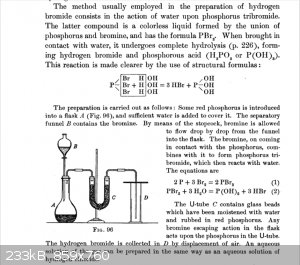
Norepi - 19-4-2017 at 03:21
This is my first post... albeit that doesn't really concern this synthesis.
I want to synthesize HBr and I'm leaning towards this reaction:
PBr3 + 3HOH -> H3PO3 + 3HBr
based off of these two texts (which I'll link at the end of this post), it appears that I could even use phosphorus triiode to obtain hydrogen iodide
via the same route.
Anyways I'm considering follow this diagram, however it seems flawed. [picture is from the second link]

First off, it's worth mentioning that I've never used an apparatus like this before, but yet I think his apparatus is flawed. HBr will only form as
the final step if there is no air present, so it's baffling to me that he doesn't have a vacuum pump to eliminate the presence of air.
His method using two sets of equations intrigues me. Nevertheless, what do you guys make of this?
https://books.google.com/books?id=Mtth5g59dEIC&pg=PA432&...
https://books.google.com/books?id=_A5DAAAAIAAJ&pg=PA262&...
Dr.Bob - 19-4-2017 at 04:04
What route works best depends far more on why you need the HBr, and in what form, and what chemicals you have, that any other factors. This is
designed for a large amount of HBr, for smaller amounts, just mixing H3PO4 with KBr would be vastly easier and simpler. If you need it as a
solution, this is overkill. Diagrams like this are a guide, if you are doing similar work, they might work well, eg, if you only need 5 mls of HBr
solution, this is too big. The idea is that once you have made a small amount of HBr, it will push out any air, and then work fine, so no need to
vacuum it out. If a trace of Br2 won't matter, then you would not need the U tube. Note that this is an older scheme, from before some other
methods might have been used, and back when every lab had red phosphorous. Most labs can get HBr solution now, so not as big need for this.
unionised - 19-4-2017 at 04:32
You say "HBr will only form as the final step if there is no air present,"
Why?
DJF90 - 19-4-2017 at 04:36
Thats what I was wondering too...
Texium - 19-4-2017 at 05:37
Looks like a huge waste of phosphorus tribromide to me. H3PO4 and KBr or NaBr is the way to go. Also there isn't a shred of organic chemistry here,
this belongs in Beginnings.
Praxichys - 19-4-2017 at 05:57
H2SO4 + bromide works too as long as the acid remains dilute enough not to oxidize the HBr to Br2.
Elemental Phosphorus - 19-4-2017 at 17:17
Frankly, the method using a bromide salt and dilute sulfuric acid would be the best, since sulfiric acid is cheaper and easier to get than H3PO4. You
could also use the method where you use bromine to oxidise aqueous sulfur dioxide.
H2SO3 (Sulfur dioxide in water) + Br2 + H2O ---> H2SO4 + 2HBr
Using PBr3 is a waste of a valuable and hard to find reagent with many uses, like preparing acyl bromides.
Norepi - 19-4-2017 at 18:13
Thank you all very much for your responses.
I placed this in 'Organic Chemistry' while debating to post it in general chemistry due to HBr being inorganic, but I simply put this post in the
wrong section without noticing.
My main motive for producing HBr is to use it as a brominating agent for organic compounds later down the road. So I'm aiming for a mixture of HBr and
H2O, hopefully before an azeotrope forms- but that's ideal.
I read that by using H2O and PBr3, HBr will be collected by the displacement of air, but I was under the impression that HBr is unstable in the
presence of O2. However after reading the comments and further researching it, it appears I am mistaken.
I'll read about methods using KBr/NaBr with H3PO4 as well as Br2 and H2SO4... or I guess it's H2SO3 since it will be in an aqueous solution
Praxichys - 20-4-2017 at 04:50
It's super easy. Just make something like a 30% solution of KBr or NaBr in water, then add a nonvolitile acid like H3PO4 or H2SO4, keeping
stoicheometry in mind (phosphoric is triprotic and sulfuric is diprotic, but your yield will be higher if you stop at hydrogen phosphate or
bisulfate). Distill this to leave the phosphate or sulfate salt behind and collect the HBr and water.
To remove discoloration from bromine and bring the HBr to a known concentration, redistill at atmospheric pressure, collecting whatever comes over at
about 126°C, which will be the constant-boiling 48% azeotrope.
Archenemy_6 - 2-5-2017 at 18:01
I just watched a Nurdrage video on making HBr earlier. I read before hand about using NaBr or KBr with H2S04 but his video uses NaBr and NaHSO4 which
can both be found at the same place. I was planning on making some eventually but I'm not sure which method to go with probably the most cost
effective one.
Amos - 2-5-2017 at 18:35
Given just how much cheaper sodium bisulfate is compared to sulfuric acid, I say give it a try and report back as to whether or not the yield is worth
it.
